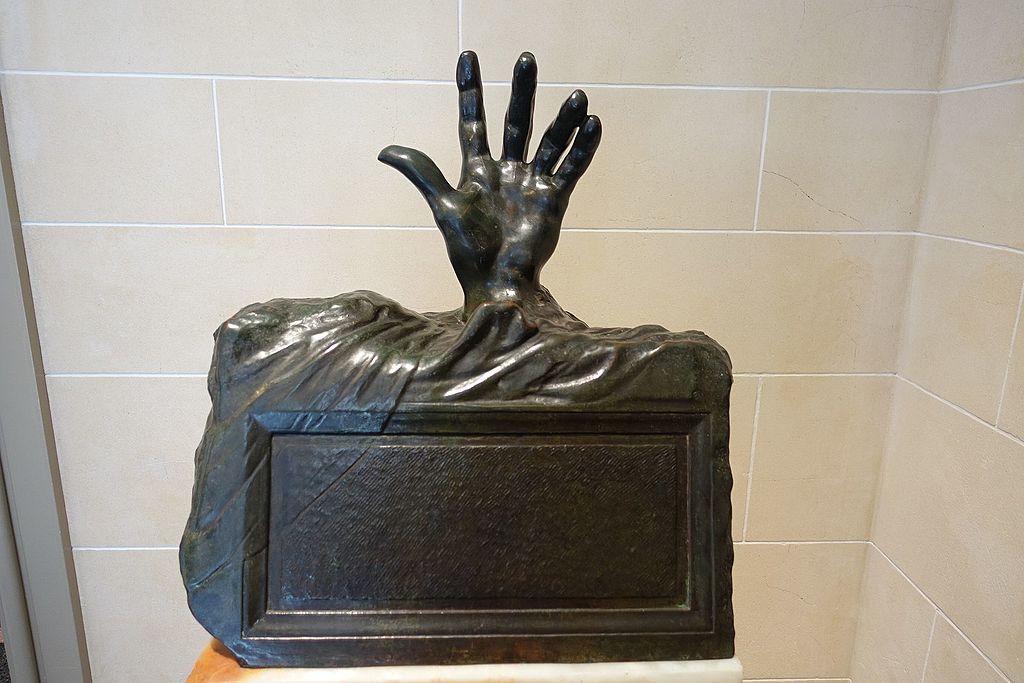
“The Hand from the Tomb” was modeled by Auguste Rodin, who shaped thousands of hands as small clay studies. Rodin experimented with different approaches to imbue the hands he sculptured with emotions ranging from anger and despair to compassion and kindness.
He kept many hand clay studies in his studio, where he would contemplate them as sculptural forms. For Rodin, the hand and the interplay of hands within groups of figures were expressive components of his sculptures. Rodin felt an:
“intense passion for the expression of the human hands.”
When Rodin composed a new figure, he often experimented with different hands at varying angles to explore the possibilities of new expressive combinations.
This approach reinforced Rodin’s interest in the partial figure. He felt that representations of parts of the body, such as the hand, are not necessarily dependent upon a complete figure to convey meaning.
Auguste Rodin
François Auguste René Rodin (1840 – 1917) was a French sculptor and one of the founders of modern sculpture.
Rodin was schooled traditionally and did not set out to rebel from the traditions of sculpture. However, Rodin’s unique works departed from traditional themes of mythology and allegory.
Rodin’s passion was to model the human body with realism. However, some of his most notable sculptures were criticized during his lifetime. Fortunately, he refused to change his style.
With successive works, Rodin’s reputation grew slowly, and he became the preeminent French sculptor, and by 1900, when he was 60 years old, he was a world-renowned artist.
Rodin is one of the few sculptors widely known outside the specialist visual arts community.
The Hand from the Tomb
- Title: The Hand from the Tomb
- Artist: Auguste Rodin
- Year: Modelled in clay 1914; cast in bronze 1925
- Material: Bronze Casting
- Dimensions: 23 5/8 x 21 3/4 x 17 inches (60 x 55.2 x 43.2 cm)
- Museum: Rodin Museum, Philadelphia
Auguste Rodin
- Name: François-Auguste-René Rodin
- Born: 1840 – Paris, France
- Died: 1917 (aged 77) – Meudon, France
- Nationality: French
- Notable work
- Eternal Springtime
- Two Hands
- The Cathedral
- The Hand of God
- The Thinker
- The Gates of Hell
- The Hand from the Tomb
- The Sirens
- Young Mother in the Grotto
- Colossal Head of Saint John the Baptist
- The Secret
- The Thinker
- The Burghers of Calais
- Balzac
- Eve
- Adam
- The Kiss
- Orpheus and Eurydice
- The Three Shades
Auguste Rodin, the father of modern sculpture
Auguste Rodin: Modeler and Sculptor
Events during Rodin’s Lifetime
- 1840
- Auguste Rodin was born in Paris
- Claude Monet was born in Paris
- 1848
- Karl Marx and Friedrich Engels published the Communist Manifesto
- 1850
- The death of Honoré de Balzac
- 1859
- Charles Darwin publishes On the Origin of Species
- 1861-1865
- United States Civil War
- 1869
- Suez Canal opens
- 1886
- Statue of Liberty was Dedicated
- 1889
- Eiffel Tower construction concludes
- 1899
- Sigmund Freud publishes The Interpretation of Dreams
- 1900
- First Paris Metro opens during the Paris World’s Fair
- 1901
- The first major exhibition of Pablo Picasso’s artwork in Paris
- 1914 – 1918
- World War I
- 1915
- Albert Einstein publishes his General Theory of Relativity
- 1917
- Rodin dies
~~~
“I invent nothing, I rediscover.”
– Auguste Rodin
~~~
Photo Credit: GM
Popular this Week








 Sponsor your Favorite Page
Sponsor your Favorite Page SEARCH Search for: Search Follow UsJoin – The JOM Membership Program
Sponsor a Masterpiece with YOUR NAME CHOICE for $5
Share this:
- Tweet
